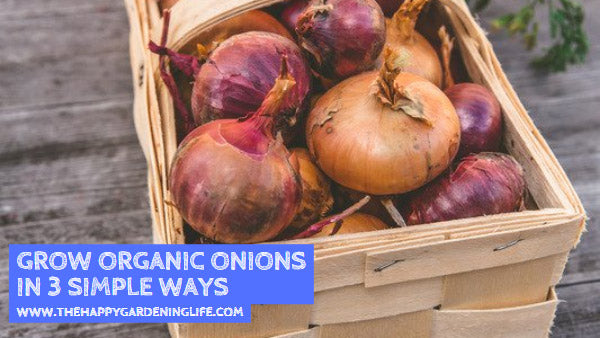
Grow Organic Onions in 3 Simple Ways
Share
 Onions are definitely a favorite among home gardeners. This delicious crop is easy to grow and useful in many dishes, that’s why several households love to plant them–especially the organic heirloom varieties.
Onions are definitely a favorite among home gardeners. This delicious crop is easy to grow and useful in many dishes, that’s why several households love to plant them–especially the organic heirloom varieties.
There are lots of organic heirloom onion varieties out there, from Burgundy Red to White Sweet Spanish, but they all share the same planting process. What you’ll need are your garden beds, pots, soil mixed with organic compost and fertilizer, heirloom onion seeds, and some water.
To get started, grow your onion seedlings in pots first before transplanting them to your garden bed.
Your raised beds should be filled with good soil and some organic compost and fertilizer. Doing this helps the structure of your soil and balances the nutrients needed for your onion plants. Next, water them moderately and regularly. After 3 to 4 months, your heirloom onions should be ready for harvest.
As long as you grow your onion plants with using the best organic methods, they will grow to their full potential in just a few months’ time. You can get more tips on this topic by reading the excerpt below.
Like this blog post? Please share it on Facebook, Pinterest, and Twitter today!
All About Growing Onions
I. When to Plant Onions
In late winter, start seeds of all types of onions — bulb onions, leeks, scallions, and shallots — indoors under bright fluorescent lights. Make additional sowings until early spring. Set out bulb onion seedlings three weeks before your last frost, and set out seedlings of non-bulbing onions six weeks before your last frost.
In spring you can also plant sets, which are small, dormant onions. Small sets produce better bulbs than large sets do.
In fall, short-day varieties can be planted in many mild winter areas. Seedlings should be ready to set out in mid-October.
II. How to Plant Onions
Choose a sunny site with fertile, well-drained soil, and loosen the planting bed to at least 12 inches deep. Mix in a 1-inch layer of mature compost. Make a 4-inch-deep, V-shaped furrow in the prepared bed. Fill the bottom of the furrow with 1 inch of rich compost or a light dusting of dry organic fertilizer, and then water the prepared furrow. Set out seedlings or sets 3 to 6 inches apart, depending on the plants’ mature size.
III. Harvesting and Storing Onions
The tops of bulb onion plants fall over naturally once the bulbs have matured. When half of the tops in a planting have fallen over, lift all of the bulbs and place the pulled plants in a warm, dry place away from direct sunshine to cure.
More Onion Growing Tips
– Choose the least weedy section of your garden for growing onions. You can start seeds early, because onion seedlings are easy to hold in containers until it’s time to plant them.
– Delay planting until the last cold spell has passed. Exposure to prolonged cold can cause bulb onions to bolt, and plants grown from sets are more prone to bolting than those grown from seedlings.
– Onion root maggots eat onion roots and bulbs. The adult flies are attracted by rotting onion tissues, so rotate onions with other crops, and compost all refuse after harvesting. Planting late can help you avoid this pest, or you can use row covers in spring, which is when the egg-laying females are most active.
– Pink root and several other soilborne diseases can cause onions to rot. Use resistant varieties, and grow all onions in well-drained sites.
Article Source: motherearthnews.com
